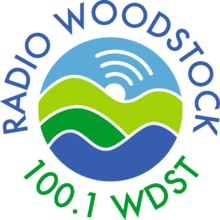WDST
 | |
| City | Woodstock, New York |
|---|---|
| Broadcast area | Hudson Valley |
| Branding | Radio Woodstock |
| Slogan | "Great Classics. Great New Rock." |
| Frequency | 100.1 MHz |
| First air date | April 29, 1980 |
| Format | Adult Album Alternative |
| ERP | 3,000 watts |
| HAAT | 96 meters |
| Class | A |
| Facility ID | 10781 |
| Transmitter coordinates | 41°59′24.25″N 74°1′5.2572″W / 41.9900694°N 74.018127000°W |
| Callsign meaning | WooDSTock |
| Owner | CHET-5 Broadcasting |
| Webcast | Listen Live |
| Website | radiowoodstock.com |
WDST (100.1 MHz), branded as "Radio Woodstock 100.1", is a radio station licensed to Woodstock, New York. The station is owned by CHET-5 Broadcasting and broadcasts with three kilowatts of effective radiated power from a transmitter located in the Town of Kingston.[1]
Radio Woodstock is known as a progressive station that was at the forefront of both the modern rock and adult album alternative (triple A) formats. The station broadcasts from the Utopia Studios in Bearsville, about 2 miles west of the Village of Woodstock.
History
WDST first broadcast on April 29, 1980, from studios in Woodstock and a tower in Lake Katrine. Initially, WDST featured a free-form format which was described as "public radio with commercials". From its sign-on until being sold in 1993, it used the slogan "The Bulldog of the Hudson Valley".
During this free-form period under Program Director Richard Fusco, though the station's eclectic format won three Billboard Magazine "Station of the Year" awards, the rock portions of the station's programming became the most listened to. WDST evolved its format more towards rock music, though free-form elements would remain until the early 1990s. Early hosts include Jeanne Atwood and nighttime DJ The Mysterious Robo. The progressive rock lean of the original format would evolve into an early modern rock format by the mid-1990s. The rise of alternative rock, a genre WDST had to itself, saw the station improve its overall listenership by the early 1990s.
In 1993, WDST was sold to CHET-5 Broadcasting along with WKNY in Kingston. Principal owner Gary Chetkof promoted Nic Harcourt to the morning show and the station was programmed with an alt-rock format. WDST soon thereafter purchased a radio station in Arlington, New York (a suburb of Poughkeepsie, New York) and simulcast WDST on 96.9 FM MHz (also known as WDSP). It was a natural extension for the 96.9 MHz signal, which debuted in the late 1980s as WEXP Next FM, offering an eclectic mix of modern rock and progressive rock elements.
In April 1997, WDSP and WKNY were sold to the Crystal Radio Group, owners of WPDH and WRRV. Because of the loss of the 96.9 MHz simulcast, much of the station's coverage south of Poughkeepsie was lost. In 1998, WDST moved its transmitter site to a tower on Hallihan Hill in the Town of Kingston, slightly north west of the city.[2] This greatly improved overall coverage in the Hudson Valley.[3] Small areas of coverage to the south were restored via translators in Newburgh (1998)[4] and Poughkeepsie (The Poughkeepsie translator service being discontinued in August 2009). Shortly after the sale, then Program Director (PD) Nic Harcourt left for KCRW in Los Angeles, California, where he hosted Morning Becomes Eclectic until December 2, 2008.
In 2010, Radio Woodstock celebrated its 30th anniversary. The station released two volumes of a 30th anniversary CD featuring live recordings from the station's rich history of hosting top talent for in-studio performances, local concerts, and its annual Mountain Jam Festival. Additionally, Radio Woodstock's year-long 30th Anniversary Concert Series featured performances in the Woodstock area by Assembly of Dust, Amos Lee, and The Hold Steady to name a few.
Programming
Greg Gattine, former PD of WPDH, is the current afternoon show host. Radio Woodstock middays are hosted by "MK” Burnell, mornings by Jimmy Buff (also Program Director), and evenings by Justin Foy (also Production Director). Radio Woodstock's programming has evolved into a more mainstream Adult Album Alternative (Triple A) format, with popular rock songs from the last 40 years (i.e. from the late 1960s to the present).
External links
- Radio Woodstock's website
- Query the FCC's FM station database for WDST
- Radio-Locator information on WDST
- Query Nielsen Audio's FM station database for WDST
References
- ↑ "WDST Facility Record". United States Federal Communications Commission, audio division.
- ↑ "WDST Application Record". United States Federal Communications Commission, audio division.
- ↑ "WDST 60 dBu service contour". United States Federal Communications Commission, audio division.
- ↑ "W293AE 60 dBu service contour". United States Federal Communications Commission, audio division.